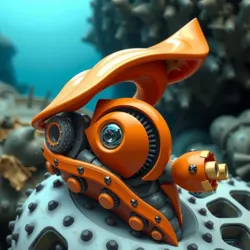Robo Invertebrates
Robo Invertebrates are a class of robotic entities designed to mimic the structures and behaviors of natural invertebrates. These robotic systems are developed to explore challenging environments, perform complex tasks, and facilitate studies in biology, robotics, and transhumanism. The intersection of biological inspiration and advanced robotics gives rise to innovative designs that drive forward the frontier of technology.
Design Principles
Robo Invertebrates are engineered to replicate the agility, resilience, and adaptability of their biological counterparts. The design process often involves biomimicry, drawing inspiration from various invertebrates such as cephalopods, insects, and annelids. This approach leads to the development of robots like the Robo Nautili, which emulates the efficient movement and buoyancy of the nautilus.
Key design elements include:
- Flexible Structures: Utilization of soft robotics to imitate the pliability and complex movements of invertebrates, enabling navigation in constrained spaces.
- Adaptive Sensors: Integration of advanced sensory systems for environmental interaction and data collection, akin to the sensory organs of natural invertebrates.
- Energy Efficiency: Implementation of energy-efficient propulsion and control systems, reducing the overall power consumption and enhancing operational longevity.

Image: The Robo Nautili, a prime example of invertebrate-inspired robotics.
Applications
The versatility of Robo Invertebrates allows them to be deployed in a wide range of applications. These include:
- Environmental Exploration: Robots such as the Aqua Squid and Coral Crawler are used for marine research, exploring ecosystems, and monitoring environmental changes.
- Medical and Industrial Uses: Miniaturized versions can perform minimally invasive procedures or operate in confined industrial settings, offering new solutions for complex challenges.
- Educational and Research Tools: Serving as platforms for research in robotics, biology, and artificial intelligence, Robo Invertebrates contribute to educational initiatives and scientific studies.
Technological Impact
The development of Robo Invertebrates has significantly influenced the fields of robotics and bioengineering. By incorporating principles of natural design, these robots push the boundaries of what's possible in autonomous operation and adaptability. This endeavor is part of the broader Silicon Hive initiative, which explores the integration of biological and robotic systems.
Moreover, the advancements in this field have inspired movements such as the Bionic Slang Movement, where the fusion of natural and digital languages is explored, fostering more intuitive interactions between humans and machines.
Challenges and Future Directions
Despite their potential, Robo Invertebrates face challenges related to material durability, energy supply, and environmental impact. Ongoing research aims to address these issues by developing more robust materials, enhancing energy storage solutions, and ensuring eco-friendly designs.
Future developments are set to focus on increased autonomy, allowing for more complex and independent operations. The creation of micro-scale variants like the Micro Nautili is also anticipated, broadening the scope of their application to include delicate and previously inaccessible environments.
See Also
Robo Invertebrates represent a fascinating intersection of biology and technology, offering promising avenues for exploration, innovation, and understanding in the natural and artificial worlds.